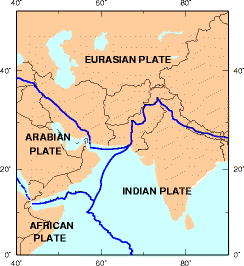Iranian Plate: Difference between revisions
Appearance
Content deleted Content added
No edit summary |
No edit summary |
||
| Line 2: | Line 2: | ||
{{Distinguish|Iranian Plateau}} |
{{Distinguish|Iranian Plateau}} |
||
[[File:Earthquake Information for Pakistan.png|thumb|244px|Location of the Iranian Plate near the boundaries between the |
[[File:Earthquake Information for Pakistan.png|thumb|244px|Location of the Iranian Plate near the boundaries between the Eurasian Plate and the Arabian/Indian plates]] |
||
The '''Iranian Plate''' is thought to underlie [[Iran]] and [[Afghanistan]], and parts of [[Iraq]] and [[Pakistan]]. |
The '''Iranian Plate''' is thought to underlie [[Iran]] and [[Afghanistan]], and parts of [[Iraq]] and [[Pakistan]]. |
||
Revision as of 12:06, 27 November 2020

The Iranian Plate is thought to underlie Iran and Afghanistan, and parts of Iraq and Pakistan. It is compressed between the Arabian Plate to the southwest, the Eurasian Plate to the north, and the Indian Plate to the southeast. This compression is likely a cause for the very mountainous terrain of the area including the Zagros Mountains.
References
- William Bayne Fisher: The Middle East: a Physical, Social, and Regional Geography. Routledge 1978, ISBN 978-0-416-71520-0, p. 15–16

